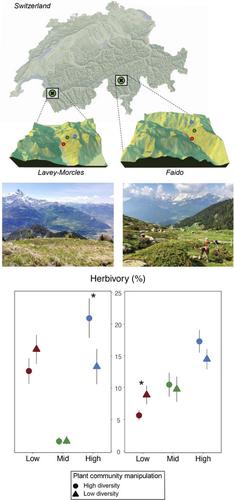Our official English website, www.x-mol.net, welcomes your
feedback! (Note: you will need to create a separate account there.)
The effect of community‐wide phytochemical diversity on herbivory reverses from low to high elevation
Journal of Ecology ( IF 5.3 ) Pub Date : 2021-03-18 , DOI: 10.1111/1365-2745.13649 Pilar Fernandez‐Conradi 1 , Emmanuel Defossez 1 , Adrien Delavallade 1 , Patrice Descombes 2, 3 , Camille Pitteloud 2, 3 , Gaëtan Glauser 4 , Loïc Pellissier 2, 3 , Sergio Rasmann 1
中文翻译:

社区植物化学多样性对草食动物的影响从低到高逆转
更新日期:2021-03-30
Journal of Ecology ( IF 5.3 ) Pub Date : 2021-03-18 , DOI: 10.1111/1365-2745.13649 Pilar Fernandez‐Conradi 1 , Emmanuel Defossez 1 , Adrien Delavallade 1 , Patrice Descombes 2, 3 , Camille Pitteloud 2, 3 , Gaëtan Glauser 4 , Loïc Pellissier 2, 3 , Sergio Rasmann 1
Affiliation

|
- Theory predicts that a large fraction of phytochemical diversity—the richness of individual chemical compounds produced by plants—governs the complexity of interactions between plants and their herbivores. While the effect of specific classes of chemical compounds on plant resistance against herbivores has been largely documented, the effect of community‐level variation in phytochemical diversity on plant–herbivore interactions has so far received minimal consideration.
- We hypothesized that plant communities bearing on average higher levels of phytochemical diversity should sustain lower herbivory rates, overall. Yet, the magnitude of this effect could vary across different environmental conditions, potentially because of climate‐mediated effects on phytochemical production and changes in herbivore community richness and composition.
- To address these hypotheses, we used previous knowledge of species‐level phytochemical make‐up for more than 400 plant species of the Swiss Alps. Using common garden experiments, we estimated season‐wide herbivore damage on low (average 3,500 unique molecules) and high (average 4,500 unique molecules) phytochemical diversity plant communities that were planted in the colline, mountain and alpine vegetation sites along two elevation transects in the Alps.
- We found that high phytochemical diversity plant communities showed reduced levels of herbivore damage in the colline (low elevation) sites, but this pattern reversed in the alpine (high elevation) sites. Our results suggest that the outcome of phytochemical diversity on plant–herbivore interactions depends on the characteristics of the local herbivore communities, together with trade‐offs between chemical defences and other plant traits (i.e. physical defences and plant palatability).
- Synthesis. Phytochemical diversity is a key component of functional diversity, influencing community composition and dynamics. We show that the effect of phytochemical diversity on herbivory is environmental‐dependent, generating ecological switches when moving from low to high elevation. Through upward movement of plants under climate change, phytochemical community structure will be likely modified, ultimately disrupting local community assembly processes.
中文翻译:

社区植物化学多样性对草食动物的影响从低到高逆转
- 理论预测,大部分植物化学多样性(植物产生的单个化合物的丰富度)控制着植物与其食草动物之间相互作用的复杂性。尽管已经大量记录了特定种类的化合物对植物对草食动物的抗性的影响,但是迄今为止,植物化学多样性的群落水平变化对植物-草食动物相互作用的影响受到的关注极少。
- 我们假设植物化学平均水平较高的植物群落总体上应维持较低的草食率。然而,这种影响的程度可能在不同的环境条件下有所不同,这可能是由于气候对植物化学生产的影响以及草食动物群落丰富度和组成的变化所致。
- 为了解决这些假设,我们使用了以前对瑞士阿尔卑斯山的400多种植物物种进行植物化学组成的知识。使用常见的花园实验,我们估算了沿草场,山坡和高山植被站点沿两个海拔样带种植的低(平均3500个独特分子)和高(平均4,500个独特分子)植物化学多样性植物群落的全季食草动物破坏。阿尔卑斯山
- 我们发现植物化学多样性高的植物群落在柯林(低海拔)部位草食动物的危害水平降低,但在高海拔(高海拔)部位这种草食动物的危害却发生了逆转。我们的结果表明,植物与草食动物相互作用的植物化学多样性的结果取决于当地草食动物群落的特征,以及化学防御与其他植物性状(即物理防御和植物适口性)之间的权衡。
- 综合。植物化学多样性是功能多样性的重要组成部分,会影响群落组成和动态。我们表明,植物化学多样性对草食动物的影响是环境依赖性的,当从低海拔向高海拔移动时会产生生态转换。通过在气候变化下植物的向上运动,植物化学群落结构将可能被改变,最终破坏当地的群落组装过程。











































 京公网安备 11010802027423号
京公网安备 11010802027423号